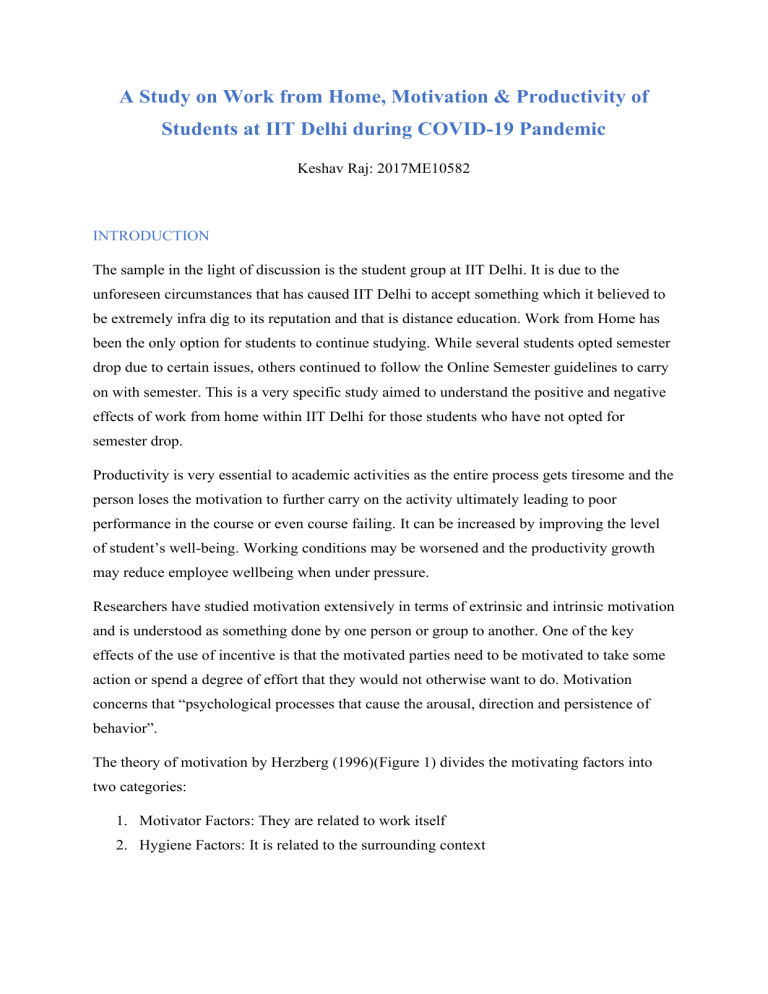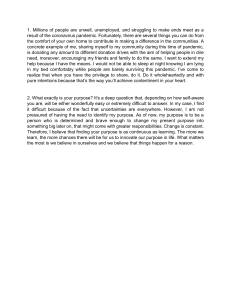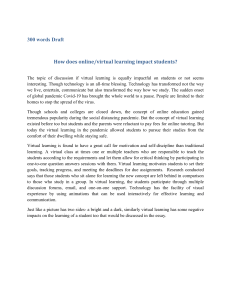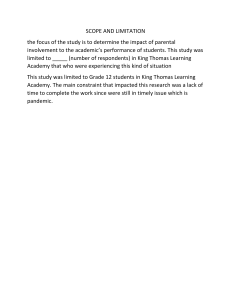
A Study on Work from Home, Motivation & Productivity of Students at IIT Delhi during COVID-19 Pandemic Keshav Raj: 2017ME10582 INTRODUCTION The sample in the light of discussion is the student group at IIT Delhi. It is due to the unforeseen circumstances that has caused IIT Delhi to accept something which it believed to be extremely infra dig to its reputation and that is distance education. Work from Home has been the only option for students to continue studying. While several students opted semester drop due to certain issues, others continued to follow the Online Semester guidelines to carry on with semester. This is a very specific study aimed to understand the positive and negative effects of work from home within IIT Delhi for those students who have not opted for semester drop. Productivity is very essential to academic activities as the entire process gets tiresome and the person loses the motivation to further carry on the activity ultimately leading to poor performance in the course or even course failing. It can be increased by improving the level of student’s well-being. Working conditions may be worsened and the productivity growth may reduce employee wellbeing when under pressure. Researchers have studied motivation extensively in terms of extrinsic and intrinsic motivation and is understood as something done by one person or group to another. One of the key effects of the use of incentive is that the motivated parties need to be motivated to take some action or spend a degree of effort that they would not otherwise want to do. Motivation concerns that “psychological processes that cause the arousal, direction and persistence of behavior”. The theory of motivation by Herzberg (1996)(Figure 1) divides the motivating factors into two categories: 1. Motivator Factors: They are related to work itself 2. Hygiene Factors: It is related to the surrounding context One of the psychological views indicates that such a strong engagement and participation in the work and such a great fit of role difficulty with ability level define very high levels of intrinsic motivation, that individuals feel some kind of psychological "flow," a feeling of merging with the operation they are doing (Csikszentmihalyi 1975). As the major physiological view suggests, intrinsic motivation works opposite to extrinsic motivation (Deci 1975; Deci & Ryan 1985). Some incentives and promised rewards are something which drives the Extrinsic motivation. In general, these theorists suggest that, when strong extrinsic motivators are put to work, intrinsic motivation will decline. So, being a part of the student community at IIT Delhi, I felt this necessary to probe into the effects of this COVID-19 situation on the same and present this forward for further inspection. METHODS The present study was a cross-sectional, observational study conducted using a simple random sampling technique at IIT Delhi. The creation of an online semi-structured questionnaire was based on Google forms. The questionnaire's connection was sent to several groups via WhatsApp. The respondents were free to roll out the survey to as many individuals as possible, but it is highly doubtful they could have done so. The link was then communicated to the maximum group of individuals. Clicking on the link directed the participants to fill the form where the participants filled in demographic data. A series of questions then emerged for the participant to answer sequentially. Being an online study, only those students who had access to internet could participate. The sample selected were students studying at home and presently enrolled at IIT Delhi. The data collection was initiated on 30th November 2020 at 1:00 PM IST and closed on 8th December 2020 at 11:00 PM IST. I was able to collect data from students in different years. The self-reported online questionnaire was taken from a study to gather data on productivity during work from home, intrinsic motivation, motivation and challenges encountered during work from home that influenced productivity exclusively in relation to work during the COVID-19 pandemic. With multiple choices, the questionnaire was developed. In the study, descriptive statistics were used to interpret the observations and to predict the study results. A sample size of 37 volunteers was used in the study. RESULTS AND DISCUSSIONS The results were analysed in four areas: 1. Productivity of students studying from home during COVID-19 pandemic. 2. Intrinsic motivational factors of the students studying from home during COVID-19 pandemic. 3. Methods used by students to motivate others like their subordinate and peer during study from home in the COVID-19 pandemic. 4. Perspective on effect of COVID-19 on study and academic work and in general 5. Challenges faced during work from home Productivity Figure. 2 indicates that 29.7 percent of total participants indicated that work productivity improved in the COVID-19 pandemic during work from home; also, 48.6 percent rejected any productivity increase. 8.1 percent of participants reported that they were not working while we collected data for analysis during the previous week, although 13.5 percent of the participants had no opinion on productivity increase or decrease because the job was less than normal. Intrinsic motivation Illustration 3 indicates that 21.6% of the respondents were unable to deal with work acknowledging that their career was in a mess. 13.5 percent of the total participants gave credit for their successful time management during lockdown to motivate themselves, while 8.1 percent of the population assumed that fear of failing was the reason for their motivation while for 18.9% of the population, the thought of affecting grades was a motivation. 16.8% of the population believed that the idea of takin one step at a time might work for them while 10.8.% of population assumed it as their responsibility and used it as their motivation. Motivating Others Illustration 4 shows that by sharing their work, 43.2 percent of participants motivated their subordinates and peers, while 27% of participants used Daily calls, ad hoc meetings, emails and providing updates on a regular basis as a motivator while 10.8 percent of participants motivated their subordinates and peers by sharing posts, encouragement images, to increase productivity during the COVID-19 pandemic. Besides all this, there was a population of 16.8% participants who acknowledged that they were not working. Perspective on effect of COVID-19 on work and in general As illustrated in Fig. 5, 29.7% of the participants felt that the pandemic created a new normal of work from anywhere while for the other 21.6% of participants, this is a warning that all humans must heed to and start to respect nature along with living life in the present believing to be extremely fragile. 18.9% of respondents believed that this will result in poor grades in courses this year while 8.1% respondents had a fear of failing course. Only 5.4% respondents had a positive outlook on the impact of the COVID-19 pandemic on nature and relationships by acknowledging that it is beneficial for earth and other creatures on earth and relationships as well. Challenges faced during work from home during COVID-19 pandemic As shown in Fig. 6, 70.3 percent of respondents expressed addiction to screen time as the greatest obstacle they faced during the COVID-19 pandemic while functioning from home. In order to work from home, 10.8 percent of participants with families found it difficult to involve children. 43.2% of the participants saw cleaning as a challenge, with cooking being a challenge for 29.7% of them. However, the study found that 37.8 percent of those involved regarded relationship tension as a difficulty in their work. There were several other problems as well which were faced by students such as problem with Internet connection and loss of social life which acted as a major deterrent in motivation. The Society will face problems in terms of work and productivity during such pandemics and epidemics. Students’ emotional well-being may be negatively affected as they are obliged to work in a lockdown. Students' knowledge of fear and anxiety may influence their outlook on motivation, efficiency and the pandemic's effect on their work in general. This report therefore attempted to assess the productivity of people working from home during the COVID-19 pandemic, intrinsic motivating factors of students working from home during the COVID-19 pandemic, strategies used by them to inspire others in the COVID-19 pandemic, such as their subordinates and colleagues during work from home, and perspective on the effect of COVID-19 on work and in general. Changes such as loneliness, social distancing, self-quarantine, travel restrictions and social media gossip are also likely to adversely affect mental health. As per our studies, we found out that 48.6% respondents were unable to increase productivity ultimately leading to work of 21.6% respondents being in complete mess while 29.7% respondents were actually able to increase their productivity probably due to the fear of failing courses and bad grades along with an effective time management. One of the effects that was also confirmed by 13.5% of respondents that the work load has actually reduced. Although motivating oneself can be very difficult for many individuals, 13.5% of respondents conveyed their intrinsic motivation over time management. Fear of failing course was felt by 8.1% of respondents as a reason to increase work productivity during COVID-19 pandemic. While we continue to see all the positives, there is a major portion of respondents who are extremely uncomfortable with the present situation and 48.6% of participants acknowledge their work to be in complete mess. The major reason which can be thought for this can be the addiction to screen time along with the stress and anxiety experienced by them. However, a large proportion of participants, around 43.2% were able to motivate others by sharing what they did while 27% participants felt the need to getting in touch was important for motivating others. At the same time when 10.8% participants shared some articles, videos etc for motivating peers and subordinates only 2.7% participants created jam up sessions online for motivating others. While there were 29.7% participants who felt that COVID-19 creates a sense that work from anywhere is a new normal, 21.6% populations believed it to be a warning for humans to respect nature and live in the present making them realize the fragility of life. 18.9% of students felt that the effect of COVID-19 would be a direct impact on grades leading to poor grades along with creating a fear of failing courses in 8.1% of participants. Introducing concepts of effective time management exclusively for students working from home can have an increased productivity. Motivating students while they are at institute and while they are working from home puts forth different challenges. However, we have obtained quite an even and interesting distributions on almost all the negative impacts of COVID-19. As we can see from the fig. 2 that a majority of students are in mess and this clearly points that there is something that is seriously wrong with the system and should be taken care of. Team of psychologists can introduce such programs for students of IIT Delhi that contribute in increasing productivity while maintaining mental health. The study is limited to the people who had access to smartphones, e-mail IDs and WhatsApp profiles. The study was essentially on students who were studying from home in IIT Delhi. CONCLUSION The study concludes that time management is a source of self-motivation to improve productivity from home during work and improves leadership skills in the form of setting an example and exchanging information as a motivational tool for others to increase productivity when working from home but a major revelation for the IIT Delhi student’s society is that they are unable to cope up with the changes due to COVID-19. The survey indicates a strong respect for nature and relationships throughout the course of the review. The survey introduced surface addiction to screen time as a big problem affecting working from home. Chores such as washing and cooking have also impacted efficiency at home during work. Several other factors which deterred the work productivity came to surface such as bad internet connectivity along with the loss of social life. ACKNOWLEDGEMENTS The present study was inspired by the contribution of MS. Seema Rani B.N, MS. Prettysha Curtis, Dr. Jayashankar Reddy K. on “A Study on Work from Home, Motivation & Productivity of Employees in Indian Population during COVID-19 Pandemic”. REFERENCE 1. MS. Seema Rani B.N, MS. Prettysha Curtis, Dr. Jayashankar Reddy K.: “A Study on Work from Home, Motivation & Productivity of Employees in Indian Population during COVID-19 Pandemic” 2. Banting, K., Sharpe, A., & St-Hilaire, F. (2002). Towards a social understanding of productivity: An introduction and overview. The Review of Economic Performance and Social Progress, 2, 1–28. 3. Kuegler, A., Schoenberg, U., & Schreiner, R. (2018). Productivity Growth, Wage Growth and Unions. Proceedings of ECB Forum on Central Banking, 215–247. Retrieved from https://discovery.ucl.ac.uk/id/eprint/10069845/ 4. Atkinson, J. W. Introduction to motivation. Princeton, NJ: Van Nostrand, 1964. 5. Campbell, J. P., & Pritchard, R. D., Motivation theory in industrial and organizational psychology, Chicago: Rand McNally, 1976. Gallup. Gallup Management Journal, http://www.gallup.com/ 6. Ilgen, D R and Klein, H J (1988) “Individual Motivation and Performance: Cognitive Influences on Effort and Choice” in J P Campbell; R J Campbell and Associates [eds] Productivity in Organizations London, Jossey-Bass 7. Kanfer, R (1990) “Motivation Theory and Industrial and Organizational Psychology” 8. Korman, A (1974) The Psychology of Motivation Englewood Cliffs, New Jersey, Prentice Hall 9. M D Dunnette, and L M Hough [eds] Handbook of Industrial and Organizational Psychology, Vol 1, 2nd edition, Palo Alto, California, Consulting Psychologists Press 10. McDougall, W. An introduction to social psychology, London: Methuen, 1908 11. Vroom, V. H. Work and motivation. New York: Wiley, 1964. 12. Workplace motivation, a review of the literature, Roderic Gray, 2000, published on the internet by, KumpaniaConsulting, www.kumpania.co.uk 13. Aalelai Vendhan M, Deepa S. Investigations on performance metrics of FINFET based 8-bit low power adder architectures implemented using various logic styles. Indian Journal of Science and Technology, 2018; 11(24), 1-21. DOI: 10.17485/ijst/2018/v11i24/111071. Figures Figure 1 Herzberg's two-factor model Figure 2 Productivity increase during work from home Figure 3 Intrinsic motivation Figure 4 Motivation of subordinates and peer Figure 5 Effect of COVID-19 on work Figure 6 Challenges faced during work from home






